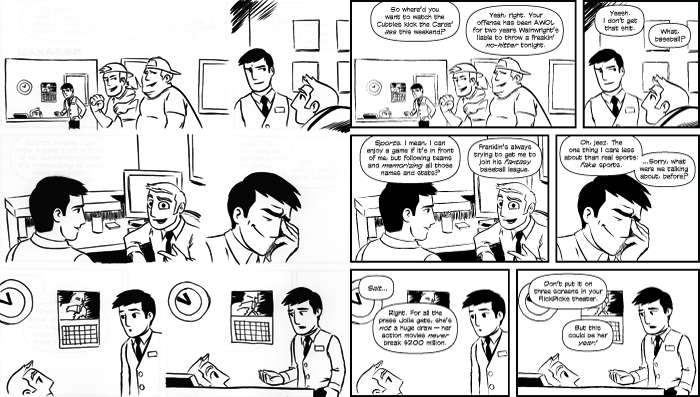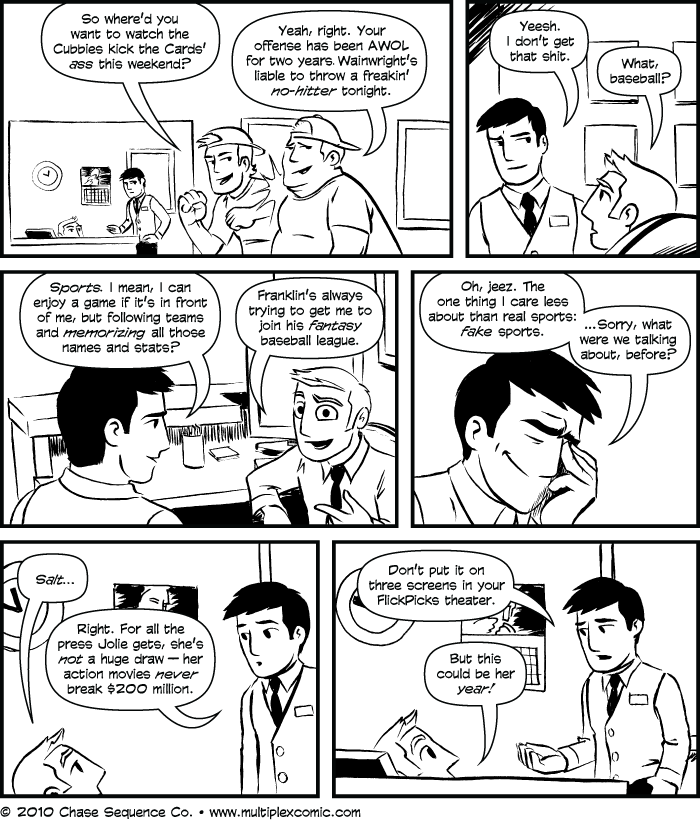In Part One, I covered how I pencil hand-drawn comics (on the relatively infrequent times that I get to do them). Next comes inking.
I left off with the finished pencils. I scan those in and print them out again onto Bristol board so that — if I screw up a page (or panel) irretrievably — I can print out a new page and take another shot.
I ink with a Winsor & Newton Series 7 #2. I’ve used cheaper brushes, but they’ve all lost their points much more quickly than some of my oldest Series 7’s. I’m sure there are other, good brands for cartooning, though; I’ve just never used one. I’ll occasionally use a #1 for smaller details (although oftentimes, it’s just as easy — or even easier — to use the larger brush), and I often pull out the old Microns for the dots of characters’ eyes or other small details where an even line doesn’t hurt.
If a brush gets a stray hair that will just not get back into shape, I use a cuticle trimmer and snip the stray hair out at its base. It keeps my brushes in active duty a lot longer.
One of the things I can never quite get the hang of with digital inking is turning the Cintiq in order to get the best line of attack on a line, like you can with a physical page. Clearly, other people don’t have this problem, so don’t take that as some sort of argument that traditional techniques are better than digital. (And, y’know, it’s me. I draw Multiplex. Obviously, I don’t have a problem with digital art.)
I generally avoid using a ruler at any point when I ink, because I like my inks to look organic (or maybe I’m just lazy). With this strip, I left the panel borders and lettering for the computer, so you can see that I just ran my lines off into the gutter and off the page; they’ll get masked off after I scan the inks in.
I keep two jars of distilled water at my table: one for my bleedproof white brush, and one for the India ink. I use Speedball, but tend to let it sit out and evaporate a bit to thicken up before I use it — if it gets too thick, I add some distilled water. I use Winsor & Newton Bleedproof White, which will solidify after sitting around in the jar, but you can just add some distilled water and stir it up and it’ll bounce back (even after months and months of sitting around).
As a leftie, I should, but I forget this a lot and end up smudging my inks sometimes. So, out comes the bleedproof white, and I’ll fix any smudges and do some light touch-ups before I scan in my inks.
Below, you can see my inks without the letters and borders (left) and then with them (on the right). Apparently I forgot to ink the word “Manager” above the Manager’s Station and the movie poster frame behind Jason in the last two panels. Oops.

Next comes the retouching. Some things you can fix more easily with bleedproof white and a little re-inking; other times, you need Photoshop. My hand isn’t especially steady, so I almost always use Photoshop and my trusty Cintiq to do some touch-ups on the final inks. I kept that to a minimum on this page, only straightening out the top of the Manager’s Station in the first panel, moving Kurt’s head down a little in the second to last panel. If I’ve forgotten to ink anything, I’ll tend to do it digitally, rather than scan in my inks again.
At this point, I’ll add in the balloon pointers and call it a day (unless I need to color it, which I’m not doing for this strip).
After the cut, you can see how the finished page looks.

So there you go. Thanks again to Kirk Damman for allowing me to post this comic (he owns the original art).
If anybody’s actually interested, I might get something ready about how I draw Multiplex in the future…? That’d probably be worth a few posts. :)

wow. convoluted, but fascinating. have you always used brushes? what are your thoughts on pens?
I’d love to see how you do a regular strip, too. it’s amazing how people differ in their methods.
I wasted a lot of time with markers and pens, because I was too scared to just try crow quills and brushes. I don’t like them for drawing a full strip, because of the lack of line variation (although obviously people like Cully Hamner get around that drawback just fine).
Crow quill pens are good — I often use them for smaller details — but I prefer the way ink goes down with brushes. I prefer the variation I can get out of a line with a brush. I prefer how brushes don’t scratch up your paper like crow quills do (at least the way I do them).
I’m not a particularly good inker, though. That’s why this isn’t a “how to”; it’s just a “how I do it.” :)
This looks amazing, I have always admired your style. Why did you choose to do it with vectors instead of this way?
Several reasons:
1) Most importantly, I just like (and enjoy making) vector illustration and when I started the strip, I wanted to get some practice doing it. Multiplex got fairly popular within a year, that was its established style, and so I’m “stuck” with it.
2) To my knowledge, there weren’t a lot of vector-drawn comics — or at least vector drawn comics drawn without line art, the way I’m doing it. There are a few more now (Wonderella is the best of them — I love Wonderella), but the art is still one of the things people comment on when they first see the strip. From what I’ve heard, it’s more of a positive than a negative. There are always going to be people who prefer one or the other, people who can’t wrap their heads around the idea that anybody could actually think 2D vector art is an appropriate technique to use to draw hand-drawn comics… whatever.
3) While developing the strip, I knew immediately that I wanted to use real movie posters and real film stills when they were talking about movies. If you drop those into hand-drawn art (especially hand-drawn art that’s done without a ruler, like how I like to draw), it looks terrible. With vector art, it’s seamless. It just looks right.
You can’t just redraw posters and have people know that a movie I’m talking about is a real movie, and there’s no way my likenesses are going to be so good that people will instantly know “oh, that’s Angelina Jolie.” For me, getting that hurdle out of the way by using real posters and film stills every time is very important.
4) One of the biggest advantages is the ability to sort of improvise the dialogue (and the characters’ expressions) in a strip and to basically be able to revise it until the very last minute. I was considering shuffling the dialogue around in panels 3–5 ten minutes before I posted the strip. With hand-drawn art,
More times than I can count, I would have been stuck with art I couldn’t revise, that didn’t serve the script the way I later decided about changing it. So I think vector art helps me write the strip better, as well.
5) I want to animate Multiplex someday. Being drawn in Illustrator, every panel for the comic, every background, every character is a new asset for the future Multiplex animated web series library. Or whatever.
Wow, I love the strip either way you chose. and those are pretty good reasons, I have always admired the quick development of your technique and how clean it looks, it might sound dumb, but I do not only read Multiplex because of it awesomeness, but I actually take Jason words literal, so his critics and reviews (which are technically yours, since I picture him being a lot like you in ral life) have made me love movies even more (if it’s possible) and not wasting 5 dlls in a bad movie. By the way I don’t know if you have seen it, but I’d like to recommend you Children of Heaven, which made my weekend. Thanks for the long reply.
“If anybody’s actually interested, I might get something ready about how I draw Multiplex in the future…? That’d probably be worth a few posts. :)”
It’s likely to be over my head, as this was, but I’d definitely be interested.